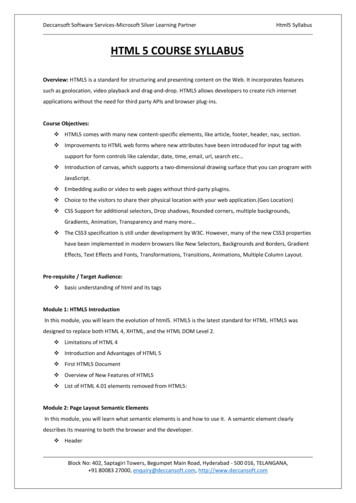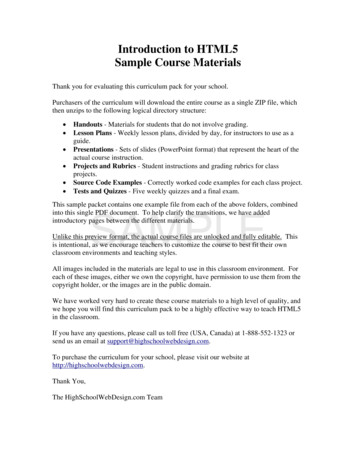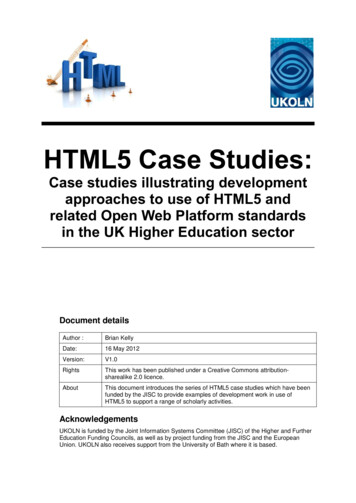
Transcription
HTML5 Case Studies:Case studies illustrating developmentapproaches to use of HTML5 andrelated Open Web Platform standardsin the UK Higher Education sectorDocument detailsAuthor :Brian KellyDate:16 May 2012Version:V1.0RightsThis work has been published under a Creative Commons attributionsharealike 2.0 licence.AboutThis document introduces the series of HTML5 case studies which have beenfunded by the JISC to provide examples of development work in use ofHTML5 to support a range of scholarly activities.AcknowledgementsUKOLN is funded by the Joint Information Systems Committee (JISC) of the Higher and FurtherEducation Funding Councils, as well as by project funding from the JISC and the EuropeanUnion. UKOLN also receives support from the University of Bath where it is based.
Table of ContentsIntroductionINTROCase Study 1:CS-1Case Study 2CS-2Case Study 3:CS-3Case Study 4:CS-4Case Study 5:CS-5Case Study 6:CS-6Case Study 7:CS-7Case Study 9:CS-8Case Study 9:CS-9About This DocumentThis document conations nine case studies which describe development approaches for theuse of HTML5 and associated Open Web Platform standards to support a variety of use casesin teaching and learning and research.
Introduction to the HTML5 Case Studies1 About This DocumentThis document provides an introduction to a series of HTML5 case studies which werecommissioned by the JISC. The document gives an introduction to HTML5 and relatedstandards developed by the W3C and explains why these developments represent a significantdevelopment to Web standards, which is of more significance than previous incrementaldevelopments to HTML and CSS.2 About HTML5As described in Wikipedia [1] HTML5 is a markup language for structuringand presenting content on the Web. HTML5 is the fifth version of the HTMLlanguage which was created in 1990. Since then the language has evolvedfrom HTML 1, HTML 2, HTML 3.2, HTML 4 and XHTML 1.The core aims of HTML5 are to improve the language with support for thelatest multimedia while keeping it easily readable by humans andconsistently understood by computers and devices.HTML5 has been developed as a response to the observation that theFigure 1: HTML5 logoHTML and XHTML standards in common use on the Web are a mixture offeatures introduced by various specifications, along with those introducedby software products such as web browsers, those established by common practice, and themany syntax errors in existing web documentsIt is also an attempt to define a single markup language that can be written in either HTML orXHTML syntax. It includes detailed processing models to encourage more interoperableimplementations; it extends, improves and rationalises the markup available for documents, andintroduces markup and application programming interfaces (APIs) for complex web applications.For the same reasons, HTML5 is also a potential candidate for cross-platform mobileapplications. Many features of HTML5 have been built with the consideration of being able torun on low-powered devices such as smartphones and tablets.In particular, HTML5 adds many new syntactical features. These include the new video , audio and canvas elements, as well as the integration of Scalable Vector Graphics (SVG)content that replaces the uses of generic object tags and MathML for mathematical formulae.As illustrated in Figure 2HTML5 is built on a series ofrelated technologies, whichare at different stages ofstandardisation (see [2]).These features are designedto make it easy to include andhandle multimedia andgraphical content on the webwithout having to resort toproprietary plugins and APIs.Other new elements, such as section , article , header and nav , aredesigned to enrich thesemantic content ofdocuments. New attributeshave been introduced for thesame purpose, while someFigure 2: HTML5 APIselements and attributes havebeen removed. Someelements, such as a , cite and menu have been changed, redefined or standardised. TheAPIs and document object model (DOM) are no longer afterthoughts, but are fundamental partsINTRO: 1
of the HTML5 specification. HTML5 also defines in some detail the required processing forinvalid documents so that syntax errors will be treated uniformly by all conforming browsers andother user agents.3 The Open Web PlatformThe Open Web Platform (OWP) is the name given to a collection of Web standards which havebeen developed by the W3C [3]. The Open Web Platform has been defined as "a platform forinnovation, consolidation and cost efficiencies" [4].The Open Web Platform covers Web standards such as HTML5, CSS 2.1, CSS3 (including theSelectors, Media Queries, Text, Backgrounds and Borders, Colors, 2D Transformations, 3DTransformations, Transitions, Animations, and Multi-Columns modules), CSS Namespaces,SVG 1.1, MathML 3, WAI-ARIA 1.0, ECMAScript 5, 2D Context, WebGL, Web Storage, IndexedDatabase API, Web Workers, WebSockets Protocol/API, Geolocation API, Server-Sent Events,Element Traversal, DOM Level 3 Events, Media Fragments, XMLHttpRequest, Selectors API,CSSOM View Module, Cross-Origin Resource Sharing, File API, RDFa, Microdata and WOFF.Use of the term Open Web Platform can be helpful in describing developments which make useof standards which complement HTML5.The list of Web standards covered by the term provides an indication of the significantdevelopments which are currently taking place which aim to provide much greater and morerobust support for use of the Web across a variety of platforms and for a variety of uses.4 Importance to Higher EducationThe Web became of strategic importance to higher education in the mid 1990s primarily in itsrole as an informational resource. As the potential of Web became better understood new typesof services were developed and the Web is now used to support the key areas of significance tohigher educational institutions: teaching and learning and research.However although innovative uses of the Web have been seen in these areas, the limitations ofWeb standards made it difficult and costly to develop highly-interactive cross-platformapplications. Such difficulties meant that significant developments in use of the Web to provideapplications (as opposed to access to information) was being led to large global companies,with Google’s range of services such as Google Docs providing an example of a widely usedWeb-based application.The experiences gained in developing such Web-based applications led to the evolution of Webstandards to support such development work. In addition the growth in popularity of mobiledevices led to the development of standards which could be used across multiple types ofdevices, in addition to the cross-platform independence which allowed Web services to beaccessed across desktop PCs running MS Windows, Apple Macintosh or Linux operatingsystems.Developments to the HTML5 standard enable multimedia resources to be embedded in HTMLresources as a native resources. In addition developments to related standards, such as SVG(Scalable Vector Graphics) and MathML (the Mathematics Markup Language) together withdevelopments to standards which support programmatic manipulation of objects defined inthese markup languages will provide a rich environment for the development of new types oftools and services which will be value to support a range of institutional requirements.In addition the support for mobile devices will enable access to this new generation ofapplications to be provided across a range of mobile devices, including iPhones and iPads,Android devices and smart phones and tablet computers which may use operating systemsprovided by other vendors.In brief the development of HTML5 and the Open Web Platform can provide the followingbenefits across higher education: A rich environment for the development of applications which can run in a Web browser. A rich environment for the development of applications which can run across a range ofplatforms and suit the particular requirements of mobile devices.INTRO: 2
A rich environment for defining the structure of scholarly resources, such as researchpapers, to support more effective processing of the resources. A neutral and open environment based on use of open standards which can provide alevel playing field for application development.5 About The HTML5 Case StudiesThe HTML5 case studies have been commissioned in order to demonstrate developmentapproaches taking place across the higher education sector by early adopters in order tosupport a variety of use cases which are particularly relevant in a higher education context.The case studies are aimed primarily at developers and technical managers who wish to gain abetter understanding of ways in which development approaches based on use of HTML5 andOpen Web Platform can be used.Whilst the examples described in the case studies are being used across a number of highereducational institutions we appreciate that not all institutions will wish to make use of theapproaches described in the case studies – in particular we recognise that institutions may nothave the development and support expertise to emulate the approaches described in thefollowing documents. However increasingly we are seeing commercial vendors making use ofHTML5 in new versions of their products. This suggests vendor support for HTML5 may be arelevant factor that in the procurement of new applications.6 Summary of the HTML5 Case StudiesThe HTML5 case studies included in this work are summarised below: Case Study 1: Semantics and Metadata: Machine-Understandable Documents by SamAdams Case Study 2: CWD: The Common Web Design by Alex Bilbie Case Study 3: Re-Implementation of the Maavis Assistive Technology Using HTML5 bySteve Lee Case Study 4: Visualising Embedded Metadata by Mark MacGillivray Case Study 5: The HTML5-Based e-Lecture Framework by Qingqi Wang Case Study 6: 3Dactyl: Using WebGL to Represent Human Movement in 3D byStephen Gray Case Study 7: Challenging the Tyranny of Citation Formats: Automated CitationFormatting by Peter Sefton Case Study 8: Conventions and Guidelines for Scholarly HTML5 Documents by PeterSefton Case Study 9: WordDown: A Word-to-HTML5 Conversion Tool by Peter SeftonReferences[1]HTML5, Wikipedia, http://en.wikipedia.org/wiki/HTML5 [2]Sergey's HTML5 & CSS3 Quick Reference. 2nd Edition, Sergey Mavrody, ISBN 978-09833867-2-8[3]Open Web Platform, Wikipedia, http://en.wikipedia.org/wiki/Open Web Platform [4]Jeffe Jappe, W3C CEO quoted in http://www.w3.org/2001/tag/doc/IAB Prague 2011 slides.html INTRO: 3
HTML5 Case Study 1:Semantics and Metadata: MachineUnderstandable DocumentsDocument detailsAuthor :Sam AdamsDate:21 May 2012Version:V1.0RightsThis work has been published under a Creative Commons attributionsharealike 2.0 licence.AboutThis case study is one of a series of HTML5 case studies funded by the JISCwhich provide examples of development work in use of HTML5 to support arange of scholarly activities.AcknowledgementsUKOLN is funded by the Joint Information Systems Committee (JISC) of the Higher and FurtherEducation Funding Councils, as well as by project funding from the JISC and the EuropeanUnion. UKOLN also receives support from the University of Bath where it is based.
Contents1About This Case Study1Target Audience1What Is Covered1What Is Not Covered12Introduction23Case Study: Searching and Rich Snippets2Person Profiles: Linked-In2Google Recipe Search34Example Application: Researchers' Homepages35Technical Discussions4Semantic data formats4Metadata available in scholarly works6Evaluation of suitability7Example works116Conclusions127Addendum12References13
1.About This Case StudyInstitutions and researchers need to maintain and grow their reputations: this means increasingthe exposure of their research outputs on the web. Embedding machine understandablemetadata into their Web sites will do this by making them more visible, easier to discover andincreasing their uses.The benefits of such approaches for institutions are: Increased exposure of research (and other) outputs, and the effect this will have onassessment metrics, and hence funding.The benefits for the individual include: Increased personal exposure and recognition. Standing out from the crowd in an ever increasingly competitive environment. Assisting their own research, making it easier and more efficient to find things. Increasing the usefulness of their own outputs.This case study reviews the current mainstream approaches to embedding machine1understandable metadata into HTML documents: microformats, RDFa and microdata – andinvestigates their use for creating 'semantic' scholarly publications.Note: all references to HTML5 microdata refer to the May 25, 2011 specification [7] unlessotherwise stated. Changes contained in the editor’s draft [8] have not been addressed.Target AudienceThis case study is primarily designed for developers and publishers interested in embeddingmachine-understandable metadata into their Web pages, those interested in extracting suchdata, and the wider community interested in the development of a semantic web.It is also hoped that the communities behind the various technologies and specifications used inthe course of this case study will be interested in the feedback regarding their usability and anylimitations encountered.Finally this study highlights areas where further work may help to develop standard approaches.What Is CoveredThis case study reviews the current state of the microformat, RDFa and microdata approachesto embedding semantic mark-up in HTML documents, and reports on their application to theencoding of semantic metadata in scholarly publications.What Is Not CoveredHTML5 adds a number of new elements for describing the structure of a Web page semantically– e.g. article, header, section. These elements have been used in the course of carryingout this case study, but will not be discussed here.Further information on the semantic HTML5 elements are available in this series of case studies[13] and Mark Pilgrim’s Dive into HTML5 [11].1Much of the information published on the web is machine-readable, but a much smallerproportion is currently machine-understandable. Information is machine-readable if it ispublished in a form that can be extracted and manipulated using a computer. If information ispublished in a machine-understandable manner, software agents can interpret it and reasonover it. Unlike humans, machines cannot infer relationships and contexts, so in order to bemachine-understandable, data must have clearly defined semantics and structure.Information published using ASCII characters in an HTML page, or in a CSV file or spreadsheet(rather than using images and PDFs) is machine-readable. However, without clear structure andsemantic annotations giving ‘meaning’ to each component of the information in a manner that asoftware agent can interpret, it is not machine-understandable.CS-1: 1
2.IntroductionOriginally the World Wide Web's content was designed solely for humans to read, not forcomputers to interpret in a meaningful way. Today the technologies to change this exist: bycreating HTML with embedded semantics we can publish documents that both humans andmachines can 'understand'. The growth in the publication of machine-understandableinformation is driving the emergence of a Semantic Web – “an extension of the current [web], inwhich information is given well-defined meaning, better enabling computers and people to workin cooperation” [2]. This is creating new opportunities, allowing heterogeneous data sources tobe integrated and making it possible for software agents to infer new insights. These can be as'straightforward' as helping users to discover information, or as complex as discovering newrelationships between known disease symptoms and potential molecular targets for new drugs[10].At the same time, it has become impractical for anyone to manually keep on top of the everaccelerating volume of published text and data. Increasingly the first reading (and filtering) ofpublications is done by a machine – this is effectively what search engines do. If you're notproviding the appropriate machine-understandable metadata – the equivalent of writing a'paragraph' for the machine to review – then the humans are unlikely to ever get to see thedocument! On the other hand, providing rich metadata will make it easier for potential users todiscover your content, and increase the likelihood that other services will direct people to yourpages.This report presents some examples showing how search engines currently exploit embeddedsemantic metadata, and demonstrates how such data can be authored. It then provides abroader review of the state of current technologies, before discussing some issues that remainto be addressed.3.Case Study: Searching and Rich SnippetsPublishing machine-understandable metadata is not 'blue skies' thinking – organisations aredoing it right now, and today's search engines are exploiting it to improve their listings andprovide a richer user experience.Person Profiles: Linked-InSearches for 'sam adams cambridge' on both Google and Bing return my LinkedIn profile highin their hits. LinkedIn include semantic markup of data in their profiles, and both search enginesextract information from this to enrich their search listings.Google displays my photo, location and current role, in what is termed a 'Rich Snippet':Figure 1. Google display of author’s LinkedIn profile.While Bing highlights my field of work, recommendations and connections:Figure 2. Bing display of author’s LinkedIn profile.These additions make the result stand-out from surrounding hits, increasing the likelihood thatsomeone will visit the page.CS-1: 2
Google Recipe Search2When one performs a search for “shepherds pie” on google.com , the search engine willpresent the user with rich results listings, and options to filter the results in meaningful ways:Figure 3. The google.com rich results listings for search term “shepherds pie”.Individual search hits (e.g. red box) can include a picture of the dish and information such as thenumber of reviews and average score, and the cooking time and number of calories per serving.Similarly the user is given options (green box) to filter the recipes (e.g. selecting those usinglamb, rather than beef!), or those that require less than 30 minutes cooking time. All this isachieved by the web sites publishing the recipes embedding appropriate semantic markup intheir pages, allowing the search engine to 'understand' the content.Similar workflows could be applied to searching in the scholarly domain, if appropriatesemantically published data is made available. If the cookery business can do this, surelyuniversities can – higher education is falling behind home-economics Web sites!4.Example Application: Researchers' HomepagesAll institutions provide homepages for their academic staff, and many for other staff andresearchers too. These can be made to appear as 'Rich Snippets' in Google results withaddition of semantic markup for a small number of metadata elements: Name Address (locality, country) Job Title Photograph (optional)The original markup is given below:2As of November 19, 2011, this functionality is only available on google.com, not google.co.uk.CS-1: 3
article h1 Sam Adams /h1 img src "tn sam-adams.jpg" h2 Cambridge (UK) based Software Developer & Consultant /h2 /article With semantic mark-up (using HTML5 Microdata / schema.org – see discussion below, fordetails): article itemscope itemtype "http://schema.org/Person" h1 itemprop "name" Sam Adams /h1 img itemprop "image" src "tn sam-adams.jpg" h2 span itemprop "address" itemscope itemtype "http://schema.org/PostalAddress" span itemprop "addressLocality" Cambridge /span ( span itemprop "addressCountry" UK /span ) /span based span itemprop "jobTitle" Software Developer & Consultant /span /h2 /article Figure 4. Resulting Google 'Rich Snippet'5.3Technical DiscussionsThe remainder of this report contains more detailed technical discussions. The technologiesdescribed above are reviewed in more detail, and some current issues discussed. Four areasare covered:1. A review of the different approaches to embedding semantic metadata into HTML5documents.2. A review of the types of data/metadata found in the different scholarly publicationsunder investigation.3. An evaluation of the suitability of each of the methods of embedding semanticmetadata for supporting the types of data required by this study.4. Production of example works with embedded metadata.Semantic data formatsThis section provides an overview of the three major formats for embedding semantics in HTMLdocuments – microformats, RDFa and microdata. For a comprehensive review of theirimplementation choices and support for different features see [15].Microformats4Microformats are simple conventions for embedding semantic mark-up about a specific domaininto human-readable (X)HTML/XML documents. here are microformat specifications supporting5a variety of types of data, a number of which have seen quite widespread up-take – e.g., hCard3Generated using the Rich Snippets Testing Tool: s4Microformats http://microformats.org/5hCard http://microformats.org/wiki/hcardCS-1: 4
6for describing people and organisations, hCalendar for describing calendars and events, and7rel-tag for marking up tags, keywords and categories in pages such as blog posts.Microformats have been designed to be straightforward for humans to use, with mark-up basedaround existing, widely used HTML features as shown in Figure 5: p class "vcard" a class "url fn" href "http://www.seadams.co.uk/" Sam Adams /a is a span class "role" software developer /span . /p Figure 5. Example of an hCard describing Sam Adams.Note in Figure 5 the vcard class on the p element indicates that the child elements form anhCard. The subsequent classes (url, fn, role) indicate the properties their elements describe.The major criticisms of the microformat specifications are:Conflicts with formatting information: Microformats make wide use of the class HTML attributewhich is more usually employed by selectors for style sheets giving presentation instructions fora page. While the HTML specifications permit the use of the class attribute "for general8purpose processing by user agents" , overloading the attribute in this manner makes itimpossible to tell whether a class attribute is being used for styling purposes, or to mark up adata field, and conflicts can arise when microformats are introduced to existing Web sites.Processing challenges: The ambiguity between data and format specification also makes itimpossible to extract marked-up data in a generic manner – a processor can only extract dataconforming to microformats that it knows about. In the above example, a processor cannotknow that it should associate the value of the a element’s href attribute with the url property,and its text content with fn (full name), unless these rules are hard-coded.Accessibility: a number of microformats use the abbr HTML element to encode text in bothhuman friendly and machine readable formats. e.g., a date-time may be encoded as: abbr class "dtstart" title "20110921T14:00:00 0100" Wednesday 21stat 2 o’clock /abbr Unfortunately this usage of the abbr element is not compatible with screen readers used bymany blind and partially sighted users which has led some organisations, most notably the BBC[14] and [5] to ban the use of microformats which make use of this pattern.Approval process / Extensibility: in order to prevent conflicts between microformat and propertynames, new microformats require centralised registration, and approval through a community9process . This can make it a lengthy and sometimes difficult process to establish a microformatfor a new type of data.RDFaThe RDFa specification provides a mechanism for embedding RDF (the language of theSemantic Web) data models into XHTML documents. RDFa brings the full power of RDF toembedding semantic data into Web documents, and is automatically compatible with the workof the Semantic Web community. In contrast to microformats, RDF/RDFa embraces ‘distributedextensibility’ – anyone can create a new vocabulary. This is achieved without having to worryingabout conflicting with another vocabulary’s names by using a URL the authors control as anamespace for the vocabulary. Technologies such as RDF Schema (RDFS) and Web OntologyLanguage (OWL) enable the construction of machine-understandable descriptions of therequired structure of RDF entities, and the separation between data and formatting mark-up,combined with more strictly specified parsing rules, ensure that problems such as the url/fnambiguity, discussed above, do not arise.6hCalendar http://microformats.org/wiki/hcalendarrel "tag" http://microformats.org/wiki/rel-tag8HTML 4.01 Specification. Chapter 7: The global structure of an HTML html9The microformats process http://microformats.org/wiki/process7CS-1: 5
RDFa has, however been widely criticised for its complexity in a number of areas:XML basis: RDFa was originally developed for use with XHTML, and, as such, requiresthat documents be well formed XML. Since up-take of XHTML has been limited, thespecification has been ported to support less well formed HTML; however, differencesbetween HTML and XML can cause difficulties when processing RDF in HTML10documents .Use of prefixes: RDFa relies on XML namespace prefixes, which, it has been argued,"most authors simply do not understand, and which many implementors [sic] end upgetting wrong" and "lead[s] to flaky copy-and-paste behaviour" [6. This is furthercomplicated by the prefixed terms (technically CURIEs, rather than QNames) appearingin attribute values which few (if any?) authoring tools understand, QNames generallybeing confined to element and attribute names.Complex formatting rules: depending on the context in which they appear, relationships inRDFa are variously expressed using either a property, rel or rev attribute, andauthors can easily be confused about which is the correct one to use for a given situation– using the wrong one can still generate a valid RDF graph, but not with the meaning theauthor intended.11The RDFa 1.1 specification, currently under development , aims to address such concerns, by: Permitting use of full URIs as property names, rather than requiring prefixed CURIEs Providing a mechanism for specifying a default vocabulary for a given scope within adocument, thereby removing the need to prefix property names Permitting the external definition of standard collections of prefixes, using ‘profile’documentsWhile RDFa 1.0 is widely used, there are very few sites or applications currently supportingRDFa 1.1.MicrodataThe Microdata specification has been created during the development of HTML5, with the aimof addressing the common use cases for embedding metadata, while avoiding some of theconcerns that are raised around microformats and RDFa. James Graham of Opera [4] (Graham,2009) has stated that, “Compared to microformats I believe the HTML 5 microdata offers moreconsistent parsing rules [.] and cleaner separation from the rest of the markup language.Compared to RFDa, microdata offers a considerably simpler authoring experience which Ibelieve to be critical to gaining traction with a large base of users.”Microdata introduces a set of new attributes for specifying data 'items' and their properties.Items can be assigned a type (defined using a URL) which provides a context for prefix-lessproperty names, similar to the role of namespaces in RDF/RDFa. Properties may also bespecified using a URL, in which case they can be applied in any context, without requiring aspecific item type. Currently there is no mechanism for providing machine-understandablespecification of microdata vocabularies, or mapping between URL and ‘simple’ property names;so it is not possible to mix ‘simple’ names from different vocabularies in a single item. Thiscontrasts with RDF/RDFa, where objects (items) can be assigned multiple classes (types), andit is straightforward to mix property names from different vocabularies.The microdata specification currently includes instructions for mapping microdata to JSON.Some earlier versions of the specification have included instructions for converting HTMLMicrodata to RDF, but they have been removed from the current draft.Metadata available in scholarly worksThis case study is not looking at adding new metadata to scholarly publications, butsemantically encoding metadata that is already being recorded. The focus is on bibliographicand citation data – i.e. metadata about the publication itself, and about other publications that itcites and references.10RDFa in HTML issues http://rdfa.info/wiki/Rdfa-in-html-issues11RDFa 1.1 Nears Completion CS-1: 6
PLoS Articles12The Public Library of Science (PLoS) is an open access publisher. Alongside the conventionalHTML and PDF formatted versions of papers they publish, PLoS also makes available raw XMLversions (conforming to the U.S. National Library of Medicine Document Type Definition (NLMDTD)). The XML files contain considerable amounts of metadata, including: Article title Author names and affiliations Citation (journal title, year, volume, pages) Publisher Publication data URL DOI Reference list – titles, authors, citation (e.g., journal title, year, volume, issue, pages)CrystalEye Entries13CrystalEye is a repository aggregating openly published crystallographic molecular structuresfrom across the Web. CrystalEye entries consist of Crystallographic Information Files andChemical Markup Language XML files describing the crystallographic structure, as well as,recently, an RDF representation of information about the crystal. There is an HTML splash pagefor each ent
As described in Wikipedia [1] HTML5 is a markup language for structuring and presenting content on the Web. HTML5 is the fifth version of the HTML language which was created in 1990. Since then the language has evolved from HTML 1, HTML 2, HTML 3.2, HTML 4 and XHTML 1. The core aims of HTML5

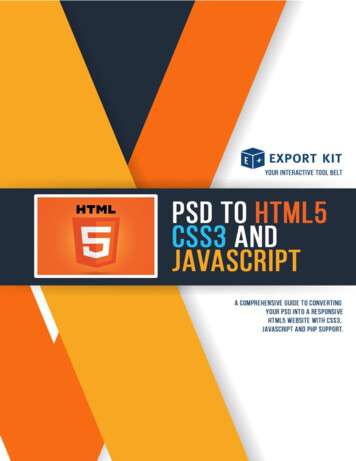
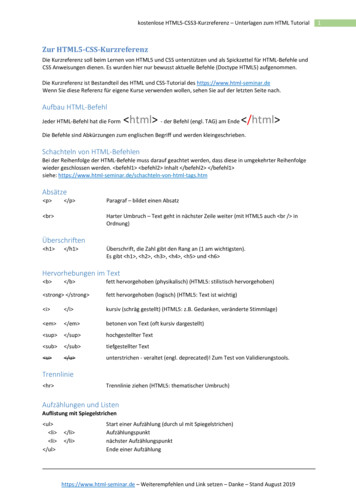
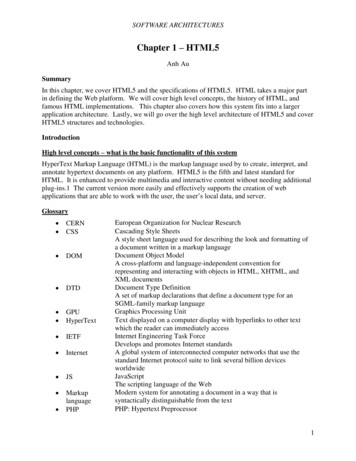
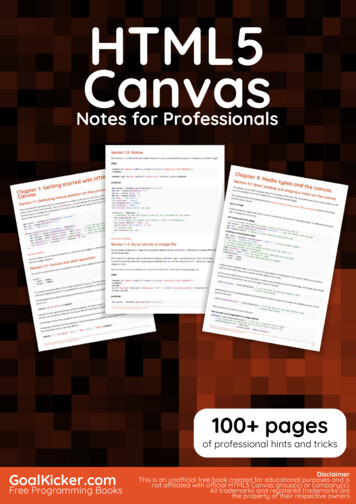
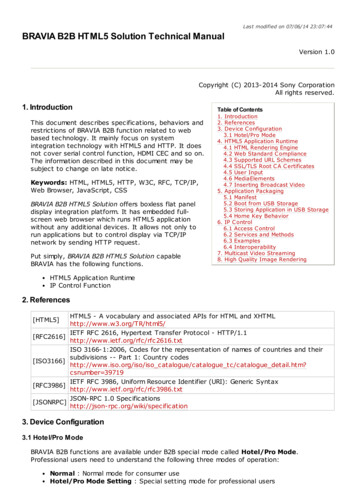
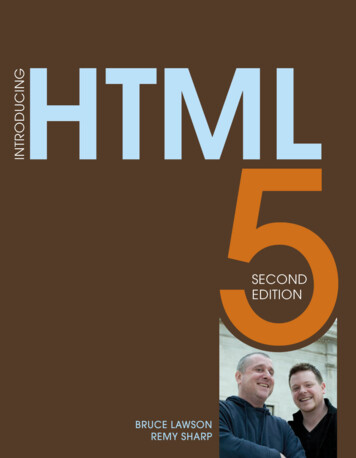
![[MS-HTML5]: Microsoft Edge / Internet Explorer HTML5 .](/img/13/ms-html5-170314.jpg)
